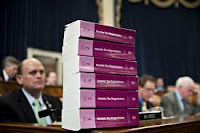On July 3, 2024 we posted Think About Adding "I Think We're Certainly Going To Be Dealing With Loper Bright Being Raised In Virtually Every Case For Quite A While," She Said., where we discussed that Our previous post on July 2, 2024 The Demise of Chevron Will Result In Increased Treasury Regulation Challenges, which discussed the demise of Chevron deference as "misguided because agencies have no special competence in resolving statutory ambiguities. Courts do," the Supreme Court's majority opinion said in Loper Bright case and a similar one called Relentless v. Department of Commer. We then went on to discuss the the US Supreme Court decided Corner Post, Inc. v. Board of Governors of the Federal Reserve System further exposes regulations to challenge.
Now According to Law360, the U.S. Department of Justice's Tax Division is seeing its casework flooded with taxpayer arguments citing the U.S. Supreme Court's decision in Loper Bright overturning the Chevron doctrine, and that's not likely to change soon, a division chief said on September 23, 2024.
Taxpayers are citing the Supreme Court's decision in Loper Bright, which struck down the Chevron doctrine giving agencies wide leeway in writing regulations, whether they even involve challenges to regulations, said Francesca Ugolini, chief of the DOJ tax division's appellate section. She spoke during the American Bar Association Section of Taxation's fall meeting, held online.
In Loper Bright, the high court's 6-3 majority tossed aside the Chevron doctrine, which instructed courts to defer to agencies' analyses in interpreting ambiguous statutes in regulations. The U.S. Supreme Court established the doctrine in its 1984 decision in Chevron v. Natural Resources Defense Council.
Ugolini said the DOJ's tax division had expected for years that the Chevron doctrine could meet its end, and that the division made a strategic shift years ago to rely more on the statute.
Have an IRS Tax Problem?
www.TaxAid.com or www.OVDPLaw.com
or Toll Free at 888 8TAXAID (888-882-9243)
Read more at: Tax Times blog






